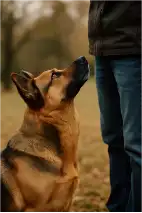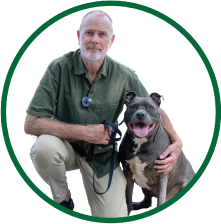What Does It Mean to Be Your Dog’s “Leader”?
 Being a leader to your dog isn’t about bullying or intimidation. It’s not about raising your voice, forcing obedience, or proving you’re in charge. That’s not leadership — that’s insecurity masquerading as control. True dominance, in the healthy sense of the word, is quiet, confident, and earned — not loud or forceful.
Being a leader to your dog isn’t about bullying or intimidation. It’s not about raising your voice, forcing obedience, or proving you’re in charge. That’s not leadership — that’s insecurity masquerading as control. True dominance, in the healthy sense of the word, is quiet, confident, and earned — not loud or forceful.
Think about the kind of leader you respect. Is it someone who barks orders, micromanages, and punishes mistakes just to remind you who’s boss? Or is it someone who sets clear expectations, builds trust, and makes you feel safe, motivated, and understood?
Dogs aren’t that different. They don’t respond well to fear. They respond to clarity, consistency, and calm authority. They thrive when they know what’s expected of them and trust that their human is steady, fair, and reliable.
This is where rules and boundaries come in. Dogs need structure to feel secure. Without clear, consistent expectations, you don’t get freedom — you get chaos. Inconsistency confuses your dog, breaks trust, and creates psychological and emotional instability. One day they’re allowed on the couch, the next day they’re scolded for it. One moment you reward a behavior, the next you punish it. Over time, this inconsistency erodes your dog’s sense of safety in the relationship.
Just like we were taught as children, dogs also need guidance to grow into balanced, stable beings.
From a young age, most of us were taught to respect personal space, to wait our turn to speak, and not to act on every impulse. We learned that just because we felt like doing something didn’t mean it was appropriate. There were boundaries — and there were consequences when we crossed them.
We also learned to regulate our emotions. We were taught that anger doesn’t give us permission to lash out, and excitement isn’t an excuse to lose control. These lessons didn’t just shape our behavior — they shaped our emotional stability. Without them, we wouldn’t have learned how to function socially, how to cooperate, or how to build healthy relationships.
Dogs are no different.
They, too, need to learn impulse control. They need to understand that not every urge should be acted on — whether that’s jumping, barking, mouthing, or chasing. They need clear, consistent boundaries so they can develop self-control, emotional balance, and social understanding. Without this structure, they don’t become “free spirits” — they become anxious, overstimulated, and unpredictable.
Guidance, not leniency, is what creates a secure, confident dog. Structure doesn’t limit their life — it opens it up.
But does that mean there’s no room for punishment? Of course not.
Punishment, when properly understood, is simply a consequence. It’s not about anger. It’s not about frustration. It’s about clarity. A dog needs to understand not only what to do, but also what not to do. When a behavior results in a calm, immediate correction, the message becomes clear: “This choice leads nowhere good.”
And let’s be clear — there is a big difference between punishment and abuse.
Punishment is brief, purposeful discomfort that interrupts unwanted behavior. Abuse is emotional — reactive, confusing, and damaging. Getting angry, yelling, yanking the leash abusively out of anger and frustration, or lashing out emotionally only creates confusion and fear. It doesn’t teach. It clouds communication. And most importantly, it’s unnecessary.
There’s no reason to get angry at your dog when you’re consistent with clear consequences. For example, if your dog jumps on a person, calmly stepping into their space and causing a moment of physical discomfort shifts their balance and interrupts the behaviour. It’s simple. It’s direct. And it works — not through fear, but through clarity.
Dogs don’t need perfection. They need consistency. And they can’t trust a leader who loses emotional control. A stable, calm correction speaks louder than any outburst ever could.
Leadership is not about power. It’s about presence. It’s the steady middle ground — guiding with confidence, correcting with fairness, and always working from a place of trust.
Because in the end, leadership is something your dog should feel, not fear. And when you get it right, the relationship becomes something deeper than obedience — it becomes partnership.
